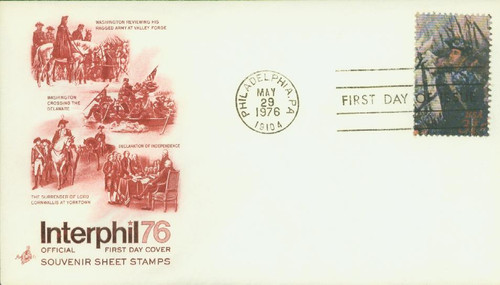
1976 31c Three Soldiers
# 1689e - 1976 31c Three Soldiers
$4.50 - $5.50
U.S. #1689e
1976 31¢ Washington Reviewing Army at Valley Forge
American Bicentennial Issue
American Bicentennial Issue
Issue Date: May 29, 1976
City: Philadelphia, PA
Quantity: 1,990,000
Printed By: Bureau of Engraving and Printing
Printing Method: Lithographed
Perforations: 11
Color: Multicolored
During the winter of 1777-78, morale was at a low point, and looking at “Washington Reviewing His Ragged Army at Valley Forge,” as it came to be called, was a very discouraging time for the patriot cause.
Following the crushing defeats at Philadelphia and Germantown, Washington led his men to Valley Forge, Pennsylvania, where they set up their winter quarters. In addition to the recent losses that had dampened the men’s spirits, there was little food or adequate clothing for the harsh winter conditions ahead. Crude huts were hastily constructed by the men to provide some type of shelter.
On December 23, 1777, Washington wrote: “We have this day no less than 2,873 men in camp unfit for duty because they are barefoot and otherwise naked.” Nearly 3,000 men died during this period, and the smallpox epidemic rendered many others too sick and weak to fight. Although Washington was severely criticized, he held his position throughout the winter and spring.
In spite of all the difficulties, however, he was able to improve his troops. With the help of the Prussian general, Baron von Steuben, who had been recommended to him by Benjamin Franklin, he drilled the soldiers in field formations and military procedures. By the spring of 1778, the patriots had become a disciplined and well-trained army.
The winter at Valley Forge tested the loyalty and strength of the American troops – only dedicated patriots had stayed with the Continental Army. On May 6,1778, news of the alliance between France and the United States reached Valley Forge. An encouraged Washington proceeded to Monmouth, New Jersey, where he successfully moved in against the British.
The Bicentennial Series
The U.S. Bicentennial was a series of celebrations during the mid-1970s that commemorated the historic events leading to America’s independence from Great Britain. The official events began on April 1, 1975, when the American Freedom Train departed Delaware to begin a 21-month, 25,338-mile tour of the 48 contiguous states. For more than a year, a wave of patriotism swept the nation as elaborate firework displays lit up skies across the U.S., an international fleet of tall-mast sailing ships gathered in New York City and Boston, and Queen Elizabeth made a state visit. The celebration culminated on July 4, 1976, with the 200th anniversary of the adoption of the Declaration of Independence.
The U.S.P.S. issued 113 commemorative stamps over a six-year period in honor of the U.S. bicentennial, beginning with the American Revolution Bicentennial Commission Emblem stamp (U.S. #1432). As a group, the Bicentennial Series chronicles one of our nation’s most important chapters, and remembers the events and patriots who made the U.S. a world model for liberty.
U.S. #1689e
1976 31¢ Washington Reviewing Army at Valley Forge
American Bicentennial Issue
American Bicentennial Issue
Issue Date: May 29, 1976
City: Philadelphia, PA
Quantity: 1,990,000
Printed By: Bureau of Engraving and Printing
Printing Method: Lithographed
Perforations: 11
Color: Multicolored
During the winter of 1777-78, morale was at a low point, and looking at “Washington Reviewing His Ragged Army at Valley Forge,” as it came to be called, was a very discouraging time for the patriot cause.
Following the crushing defeats at Philadelphia and Germantown, Washington led his men to Valley Forge, Pennsylvania, where they set up their winter quarters. In addition to the recent losses that had dampened the men’s spirits, there was little food or adequate clothing for the harsh winter conditions ahead. Crude huts were hastily constructed by the men to provide some type of shelter.
On December 23, 1777, Washington wrote: “We have this day no less than 2,873 men in camp unfit for duty because they are barefoot and otherwise naked.” Nearly 3,000 men died during this period, and the smallpox epidemic rendered many others too sick and weak to fight. Although Washington was severely criticized, he held his position throughout the winter and spring.
In spite of all the difficulties, however, he was able to improve his troops. With the help of the Prussian general, Baron von Steuben, who had been recommended to him by Benjamin Franklin, he drilled the soldiers in field formations and military procedures. By the spring of 1778, the patriots had become a disciplined and well-trained army.
The winter at Valley Forge tested the loyalty and strength of the American troops – only dedicated patriots had stayed with the Continental Army. On May 6,1778, news of the alliance between France and the United States reached Valley Forge. An encouraged Washington proceeded to Monmouth, New Jersey, where he successfully moved in against the British.
The Bicentennial Series
The U.S. Bicentennial was a series of celebrations during the mid-1970s that commemorated the historic events leading to America’s independence from Great Britain. The official events began on April 1, 1975, when the American Freedom Train departed Delaware to begin a 21-month, 25,338-mile tour of the 48 contiguous states. For more than a year, a wave of patriotism swept the nation as elaborate firework displays lit up skies across the U.S., an international fleet of tall-mast sailing ships gathered in New York City and Boston, and Queen Elizabeth made a state visit. The celebration culminated on July 4, 1976, with the 200th anniversary of the adoption of the Declaration of Independence.
The U.S.P.S. issued 113 commemorative stamps over a six-year period in honor of the U.S. bicentennial, beginning with the American Revolution Bicentennial Commission Emblem stamp (U.S. #1432). As a group, the Bicentennial Series chronicles one of our nation’s most important chapters, and remembers the events and patriots who made the U.S. a world model for liberty.












